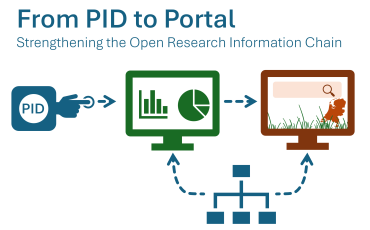Last week SURF hosted an ORI community event and saw participants from universities, NWO, UNL, KNAW, and more. John Doove opened the day by addressing why open research information has gained more traction in recent years. A few reasons being the emergence of the Open Research Information Agenda (ORIA) replacing the initial Open Knowledge Base (OKB) plan and the phasing out of NARCIS. John outlined three layers of why this community does what it does:
-
Why research information is important: if we don’t register who produces what, when, with which funding it will be harder to monitor and account for
-
Why open research information is important: if research information is openly availably transparency of the information is enhanced
-
Why should we, as a research community, work on research information under public governance: enforcing standards and principles and safeguarding autonomy on use of research information (digital sovereignty).
John’s quiz reminded us of the extensive history and knowledge behind PIDs. Congrats to Rutger, Maarten, and Ellen for being top scorers!
Presentation conclusions
Bianca Kramer quipped that metadata can play a role in open research information in two ways: 1) as a primary source for PIDs and 2) as a secondary source for enrichment of existing records. Her study on quality of open data sources looked at OpenAIRE and OpenAlex. In comparing the two, Bianca showed that OpenAIRE was missing data that was in OpenAlex. There was a suggestion from the audience to use OpenAlex to enrich OpenAIRE. It is evident that there’s work to do to improve the metadata coverage and quality. Her main conclusions:
-
Open data sources are complementary in record coverage and metadata coverage
-
PIDs facilitate retrieval, matching and enrichment of records
-
Institutions can improve coverage of ‘their’ research output in open data sources, increasing value for everyone
-
Institutions can put pressure on other stakeholders
Clifford Tatum introduced us to an up-and-coming PID: RAiD, which is a DOI for research projects. The RAiD’s focus is on openness and the FAIR principles. It contains a register for curated metadata about the project and all the research objects related to that project pointing to other persistent identifiers, such as the ORCID for project members, a handle for research equipment that points to the DOIs of the datasets output, and the DOIs of the publications. Based on the ISO standard, there are multiple reasons for the added value of a project ID:
-
Projects provide a clear boundary, at the point of administering a project
-
Linking objects together and making cohesive relationships
-
Beneficial for funders with regards to knowing what the outcome of projects are (when recorded)
-
A project can evolve into second generation project
Jeffrey Sweeney presented the objectives and outcomes of the PID Graph Pilot. The aim was to ingest (incomplete) metadata from different CRIS systems and demonstrate that with more ingesting sources making assertions about a research entity, the more complete a metadata record will become. Provenance is important for bringing trust and reliability to the system. The experiment explored the possibilities of making inferred assertions to research entities, which is useful for new ways of reporting.
Maurice Vanderfeesten demonstrated the outcomes of the Next Narcis project (The Netherlands Research Portal), where all Dutch repositories and CRIS systems are providing their content to the OpenAIRE Graph. In this graph, additional information is being inferred and offered back to the repositories and CRIS systems to enrich and improve their records. Maurice presented an information architecture that, with the right conditions, can contribute to the goal of high quality, freely available and open research information, that can be used by others to build new services for discovery, reporting and more. He pointed out that this portal is now governed by no one, but needs to be picked up. Additional efforts need to be made to govern the information process, and to increase the completeness and quality of the metadata in order to reliably report a research for evaluation and accountability.
Thomas van Himbergen introduced the ORI team at SURF and outlined the program. He then facilitated an interactive fishbowl activity. Some got active and jumped into the “bowl” discussion to talk about the existing landscape, responsibilities (on metadata quality), and possible solutions. Contributions on potential new projects such as a RAiD pilot also surfaced.
This day was a good reminder that making research information open is a community effort. We need input from all “corners of the room”, so to say. Your experiences, ideas, and feedback are invaluable. We encourage everyone to share their thoughts and experiences here in this community.
Glossary & Abbreviations
ORI: Open Research Information
PID: Persistent Identifier
Handle: resolving mechanism for PID's (keeps track of the web locations of an ID; to redirect upon request)
DOI: Digital Object Identifier, that is a PID, based on handle
Crossref, DataCite, RAiD: registration agents for minting DOI's, that uphold metadata standards and a metadata register
ROR: Research Organisation Registry, that is a PID, and a registration agent.
ISNI: International Standard Name Identifier, that is a PID
ORCID: Open Researcher and Contributor Identifier, that is a registration agent for minting ISNI's
OpenAlex, OpenAIRE Graph: large research entity databases that index all PID's including metadata, and links between them



2 Praat mee